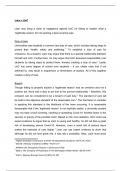Essay
First Class Tort Law Essay
- Module
- Tort Law
- Institution
- The University Of Kent (UKC)
First-class essay responding to a problem questions scenario. Covers common law duty of care, duty of care for omissions, material increase in risk test, but for test, volenti non fit injuria, test of knowledge, employer/employee relationship, duty to provide a safe space and system of work, standa...
[Show more]



